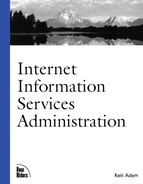Chapter 7. Running Web Applications
Although the majority of web sites today contain static content—that is, standard HTML pages—many companies are finding that it takes something a little more exciting to attract, keep, and provide value to their customers. Web applications allow Webmasters to pull information from databases, accept product orders online, personalize pages for individual users, and provide a myriad of other services to their users. As an Internet Information Services administrator, you will need to enable these applications for your clients and possibly even educate your clients a bit on their value. This chapter provides you with the information you will need to complete these tasks; however, it does not teach you how to create Web applications or code within Web pages. You might find that helpful, or maybe even necessary, in your specific job, but it is not something that the normal Internet Information Services administrator will need to know. For that reason, this topic isn't covered here.
The Web applications discussed in this chapter are executed and processed on the Web server. These applications are different from client-side executables. The advantages of server-side applications over client-side applications include browser independence, better bandwidth utilization, and logged application errors. With client-side applications, none of these are available.
The chapter covers the following topics:
An overview of Web applications running on Internet Information Services
MIME types and how they are configured
ISAPI applications
ASP applications
How to load and configure a Web application in Internet Information Services
